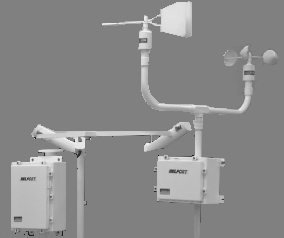Atmospheric pressure is the force per unit area exerted by the atmosphere at a
given point. The term "barometric pressure" refers to the actual pressure
sensor value. The sensor value may be an altimeter setting, station pressure,
or simply a direct pressure value without applied corrections depending on the
type of sensor.
 Atmospheric Pressure Parameter
Definitions and Criteria
Atmospheric Pressure Parameter
Definitions and Criteria
Station pressure
The atmospheric pressure at the designated station elevation.
Altimeter setting
The pressure value to which an aircraft altimeter scale is set so that it
will indicate the altitude above mean sea level of an aircraft on the ground at
the location for which the value was determined.
Sea-level pressure
A pressure value obtained by the theoretical reduction of barometric
pressure to sea level. Where the Earth's surface is above sea level, it is
assumed that the atmosphere extends to sea level below the station and that the
properties of that hypothetical atmosphere are related to conditions observed
at the station.
 Atmospheric Pressure Observing
Standards
Atmospheric Pressure Observing
Standards
Pressure Observing Standards
 Atmospheric Pressure Reporting
Standards
Atmospheric Pressure Reporting
Standards
- Rounding Pressure Values. When computations of pressure values require
that a number be rounded to comply with standards on reportable values, the
number shall be rounded down to the next reportable value. For example, an
altimeter reading of 29.248 inches becomes 29.24 and a station pressure reading
of 29.249 inches becomes 29.245.
- Units of Measure. Table A-21 lists the units of measure for pressure
parameters.
| Table A-21. Units of Measure of
Pressure Parameters |
| Parameter |
|
| Altimeter Setting |
Inches of Mercury |
| Sea-Level Pressure |
Hectopascals |
| Station Pressure |
Inches of Mercury |
- Altimeter Setting. Altimeter setting shall be reported in all reports.
- Sea-Level Pressure. At designated stations, sea-level pressure shall
be included in the remarks section of all METARs.
- Remarks. At designated stations, the pressure change remarks
(PRESRR or PRESFR) shall be reported if occurring at the time of
observation. The pressure tendency group shall only be included in 3- and
6-hourly reports.
 Summary of Atmospheric Pressure
Observing and Reporting Standards
Summary of Atmospheric Pressure
Observing and Reporting Standards
| Table A-22. Summary of Pressure
Observing and Reporting Standards |
| Altimeter Setting |
Reporting Standard |
| Altimeter Setting |
Reported in inches of mercury at all stations |
| Sea-level Pressure |
Reported in hectopascals at designated
stations |
Remarks:
Rising Rapidly
Falling
Rapidly |
Reported at designated stations |
| Pressure Tendency |
Reported at designated stations |
 Coding of Atmospheric Pressure
Groups
Coding of Atmospheric Pressure
Groups
Coding the Altimeter Setting Group (APnPn
PnPn)
The altimeter group always starts with an A
(the international indicator for altimeter in inches of mercury). The
altimeter shall be coded as a four digit group immediately following the
A using the tens, units, tenths, and hundredths of inches of mercury.
The decimal point is not coded.
Note: The WMO standard is to report the altimeter in whole hectopascals.
In this case, the altimeter setting group will be begin with a Q instead
of an A.
Coding the Sea-level Pressure Group (SLPppp)
The sea-level pressure group (SLPppp) is included in the remarks secion
of the message. Only the tens, units and tenths of hectopascals is included
prefixed with SLP. A sea-level pressure of 1002.5 hectopascals would be
encoded as: SLP025.
Return to First Page Index


 Atmospheric Pressure Parameter
Definitions and Criteria
Atmospheric Pressure Parameter
Definitions and Criteria
 Atmospheric Pressure Observing
Standards
Atmospheric Pressure Observing
Standards
 Atmospheric Pressure Reporting
Standards
Atmospheric Pressure Reporting
Standards
 Summary of Atmospheric Pressure
Observing and Reporting Standards
Summary of Atmospheric Pressure
Observing and Reporting Standards
 Coding of Atmospheric Pressure
Groups
Coding of Atmospheric Pressure
Groups